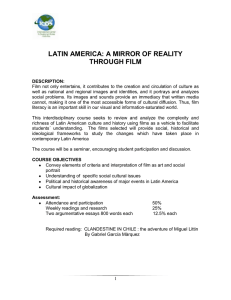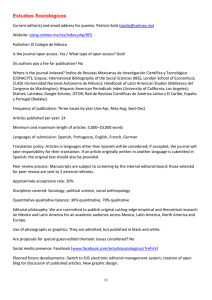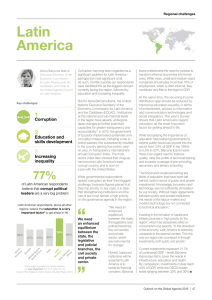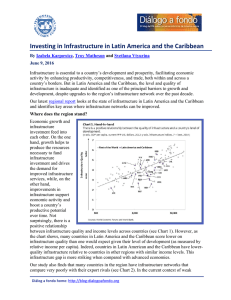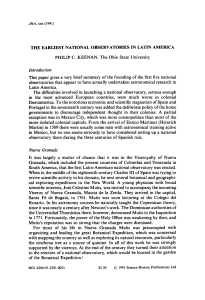China and Latin America, a new relationship scenario?
Anuncio
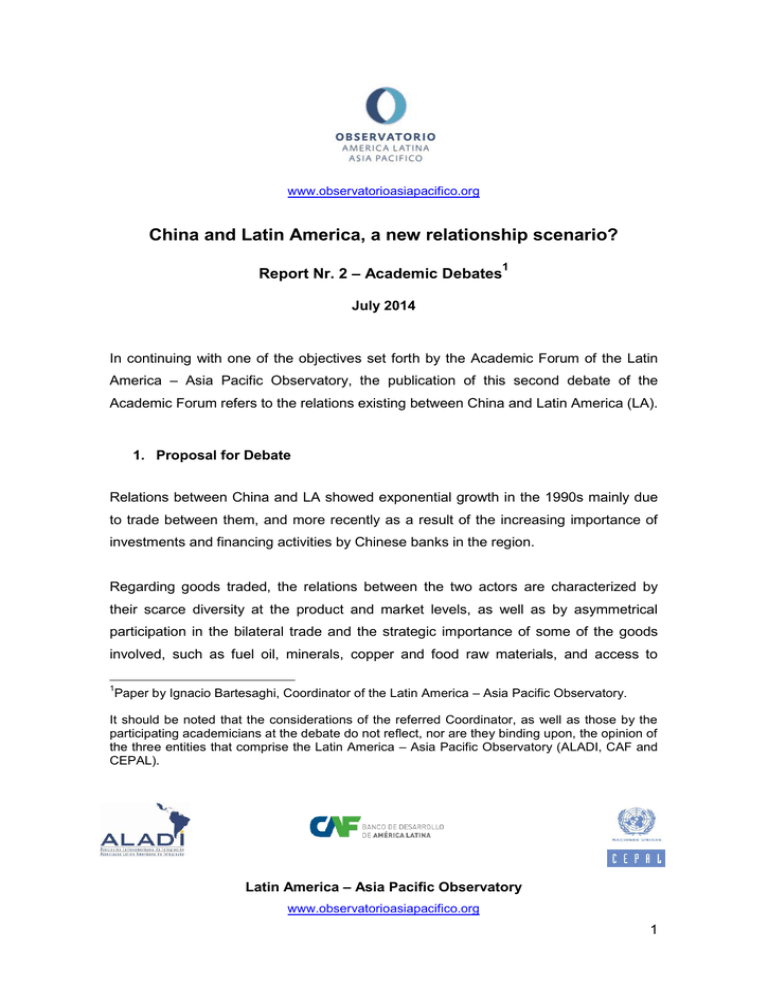
www.observatorioasiapacifico.org China and Latin America, a new relationship scenario? 1 Report Nr. 2 – Academic Debates July 2014 In continuing with one of the objectives set forth by the Academic Forum of the Latin America – Asia Pacific Observatory, the publication of this second debate of the Academic Forum refers to the relations existing between China and Latin America (LA). 1. Proposal for Debate Relations between China and LA showed exponential growth in the 1990s mainly due to trade between them, and more recently as a result of the increasing importance of investments and financing activities by Chinese banks in the region. Regarding goods traded, the relations between the two actors are characterized by their scarce diversity at the product and market levels, as well as by asymmetrical participation in the bilateral trade and the strategic importance of some of the goods involved, such as fuel oil, minerals, copper and food raw materials, and access to 1 Paper by Ignacio Bartesaghi, Coordinator of the Latin America – Asia Pacific Observatory. It should be noted that the considerations of the referred Coordinator, as well as those by the participating academicians at the debate do not reflect, nor are they binding upon, the opinion of the three entities that comprise the Latin America – Asia Pacific Observatory (ALADI, CAF and CEPAL). Latin America – Asia Pacific Observatory www.observatorioasiapacifico.org 1 competitive manufactures relevant for industrial development in LA, among others. In sum, except for particular cases such as Mexico, and Costa Rica to a lesser extent, relations between LA and China are supplemental, with China exporting manufactured products implying significant processing and technological content and Latin American countries exporting primary goods and manufactured products based on natural resources. The relation that exists between China andLAhas led to a profound debate regarding the effects of such relation. On one hand, Latin American countries have shown, throughout the past decade, a historical performance of their GIPs that was absolutely boosted by the strong Chinese demand for some primary goods. On the other hand, the trade pattern between Latin American countries and China would be the reason behind the re-primarization of exports. This added to the Chinese competitiveness in local and regional markets have increased the de-industrialization of some economies. Even in the absence of a full academic consensus regarding such diagnosis, particularly due to the significant differences between the various countries in the region, most of the specialized economic bibliography in this regard includes this definition of the trade relation between the two actors referred. Based on the internal transformations currently taking place in China, most of which are evident in the outcome of the 3rd Plenary Session of the Chinese Communist Party, experts foresee a change of scenario in the relations between China and foreign countries, particularly considering regulatory modifications that will have an effect on that country’s internal market, and also due to the new aspects that will characterize China’s foreign trade of goods and services. At the light of this new reality, LA faces the challenge of promptly adopting an agenda with issues so far inexistent in the bilateral relation but present in the agendas of other countries in the Asia Pacific region. Latin America – Asia Pacific Observatory www.observatorioasiapacifico.org 2 The new debate proposed by the Latin America Latina – Asia Pacific Observatory is intended to consider this, upon the vision of academicians and specialists from the two regions, and based on some questions to be used as guidelines. Some questions to guide the debate Is it possible and/or necessaryto change the trade pattern currently governing the relations between LA and China? Which countries in the region are best prepared to adapt to China’s transformations? Is it possible to increase trade complementarity with China in sectors other than the trade of goods? Is it necessary for LA to define shared positions in its relation with China?, Or should we expect different productive structures to lead to differences in the relations with that country? Could tensions result within or among the region’s integration processes due to differences in the policies applied regarding relations with China? What is the Latin American role that China acknowledges in this new scenario? Latin America – Asia Pacific Observatory www.observatorioasiapacifico.org 3 2. Contributions by Academicians2 Following is a review of the contributions by the academicians who took part in the 2 nd Debate of the Academic Forum.Comments have been grouped according to various fields of interest, where the main ones were: Implications of the trade pattern between LA and China. China’s role in productive structures. Business Opportunities. The strategy defined. New dimensions in the relation. Implications of the trade pattern between LA and China The pattern characteristic of trade relations between LA and China is one of the most debated issues in analyzing the relation of the two actors. In this regard, there is a natural coincidence in the predominant trade pattern between LA and China, where primary goods and agro-industrial products are exported (even when some Latin American countries have advanced in the processing degree of the agricultural manufactured products they export to China)and manufactured products with significant processing and technological content are imported. This pattern has been 2 The contributions by the following academicians and entities is highly appreciated (indicated in order of appearance in the debate): Annalissa Tabarini Herrera (Guatemala), Roberto Hernández Hernández (Mexico), International Trade and Integration Department of the Catholic University of Uruguay, Xulio Ríos (Spain), Mariano Bullón Méndez (Cuba), Evelyn S. Devadason (Malaysia), Mariano Turzi (Argentina), Vinicio Sandi Meza (Costa Rica), Gustavo Santillán (Argentina), Haibin NIU (China), Florencia Rubiolo (Argentina), Gabriela Correa López (Mexico), Francisco Javier Haro Navejas (Mexico), and Félix Peña (Argentina). The Coordinator of the Latin America – Asia Pacific Observatory is fully responsible for the construction of the comments made by the referred academicians and entities, and such construction does not reflect nor bind the opinion of the debate’s participants. The original comments by the participating academicians are available at: http://www.observatorioasiapacifico.org/OBSExternalUI/pages/public/debateForm.jsf?di=7 Latin America – Asia Pacific Observatory www.observatorioasiapacifico.org 4 defined as the same existing between the Latin American countries and the world’s largest economies, then deriving into a dependent relation with China as well. The growing investment trend in China also contributes to reaffirming the referred pattern. In this regard, the main issue that experts deal with is the possibility of modifying that reality both in terms of incentives and in terms of the actual control of the dynamics that explain the current trade pattern between the two actors (the interest of elite groups). In order to change this scenario, LA is expected to modify its development model, for which purpose it should strengthen its policies relative to investments, education, technology and physical and digital infrastructure. Such policies will enable a greater sophistication of the region’s productive structures, most of which hinder the change of the exporting offer of Latin American countries. Apart from changes to the referred public policies, some cases mention the difficulties affecting Latin America’s integration process, which obviously affects the productive development of these countries and their inclusion in the international scene. Some participations call for a greater diversification of markets, beyond the Chinese market, which would counterbalance the negative balance of trade of several countries in the region in relation to China, with Mexico being the most representative case. Likewise, the relation with China must also be diversified in relation to products exported, with added technology (which, as explained further ahead, could be partially provided by China). In sum, the structural change would be promoted by the creation of global value chains, such as those that China has with countries in southeast Asia. In the opinion of some academicians, the governance of the global value chains phenomenon is key in understanding the trade pattern that currently characterizes the relation between Latin America and China, led by actors competing for its control, and this is something that calls for particular attention by Latin America. An opinion shared by all is that it is Latin America, and not China as many might think, who is responsible for enabling this kind of trade with the Asian giant. Notwithstanding, Latin America – Asia Pacific Observatory www.observatorioasiapacifico.org 5 China pursues specific objectives and interests in the region, which are defined in accordance with a policy that relates to the fulfillment of such objectives. China’s role in productive structures Both in the academic field and beyond, China is evidently recognized for its long-term vision in relation to implementing its foreign policies, and this is a virtue not commonly recognized in Latin American States. As well, the relations between the two actors in recent years have acquired a significance acknowledged both at the trade and the investment level. Within this context, academicians increasingly consider the need to strengthen the relation with China by means of an associative and cooperational logic, with special focus on promoting channels such as investment (very much called for in areas other than the primary sector), transferring technology, and implementing joint ventures, among other aspects. In this regard, some participants believe that the good use of resources entering the region as a result of trade with China is fundamental. This was a topic considered by several international bodies and brings about the discussion of the use of extraordinary resources received in the region through the significant trade taking place with China (capital), which should be applied in implementing policies to promote the transformation of productive structures, which requires the incentive of investments in science, technology and innovation. The role played by SMEs in international trade is indicated as a key aspect in the possible changes that might occur in the region’s productive matrix, in addition to the definitive implementation of regional agendas including the significance of productive chains for the region’s development. Latin America – Asia Pacific Observatory www.observatorioasiapacifico.org 6 These dynamics, added to the internal transformations of the Chinese market and its scale, could lead to new synergies that might enable a more refined productive matrix in LA. Even with such changes implemented, the challenges continue to exist in the adjustment of the region’s public policies, many of which do not favor investments in the more sophisticated sectors of international trade. Business Opportunities The magnitude of the transformations currently in progress in China matches the impact of such transformations on international trade. In this regard, it has been remarked that the relations between the two actors have started a new stage, particularly due to the new advances that will result from the changes to the internal market and the liberalization of the external market, all of which are reforms that Chinapromotes towards achieving sustainable growth. Experts remarked the potential of certain sectors like the services trade, where Latin America has great possibilities for investment due to the degree of specialization reached by the sector in some Latin American countries, and also due to the still scarce development of Chinese foreign trade in relation to services (at least when compared with foreign trade involving goods). Participants also warned about the fact that not all countries in the region are equally capable of responding to business opportunities and the increasingly noticeable asymmetries that this will generate between Latin American countries. They even expressed doubts about the accurate comprehension –with the need for improved diagnosing capabilities- that the region might have of all the business opportunities generated as a result of a consolidated “worldwide middle class”, which not only requires prepared foods (in relation to which Latin American countries are indeed highly competitive) but also other manufactured goods that imply great opportunities in the Asian market. Concerning this sector, though there is agreement in regards to the Latin America – Asia Pacific Observatory www.observatorioasiapacifico.org 7 difficulties implied in exporting high-technology goods to China, the gradual increase of value of deposits resulting from Chinese investments in the agriculture or energy sectors is considered possible. The strategy defined Since the so-called “White book of relations between China andLatin America” became public, the debate on how LA should relate to China has gained relevance. From that point onwards, some academicians started to claim a joint response by Latin American countries to such policy. The various strategies towards China shown by countries in LA, both in the trade and political scenarios, have proven difficulties in attaining the referred objective. In recent years, Latin American countries have had different degrees of participation in Asia’s integration processes, like the case of the APEC and the TPP. Also, some countries have made bilateral advances by subscribing trade agreements with aggressive strategies for opening scenarios with Asia Pacific and particularly China,while other countries have shown protectionist policies in relation to China. Additionally, some members of the Forum have proposed the consideration of political differences still remaining, since most of Central America’s current diplomatic relations with Taiwan somehow prevent the definition of shared policies. But further to this reality, the relations of several Central American countries, at the economy and trade levels, continue to experience a fast growth regardless of their diplomatic acknowledgment of Taiwan, with several examples confirming this fact. In the absence of common positions, China has made bilateral advances with the different countries in the region, proposing various strategies that mainly favor its own interests. Other opinions question the need for LA to define common positions for relations with China, and acknowledge the difficulties implied as a result of different productive structures, among other factors. Some cases even assert the non-possibility Latin America – Asia Pacific Observatory www.observatorioasiapacifico.org 8 to reach common positions in this sense and indicate the probable definition of different profiles. Though deemed necessary, the boost of bilateral relations does not seem to be the best scenario for maximizing the relation with this Asian giant, indicating as well, that FTAs are not necessarily the most appropriate means for this objective. Nevertheless, there is some coincidence regarding the need for consensus, for which purpose the CELAC-China Forum could provide an adequate environment, though the expectations for agreements on specific issues relative to international trade are scarce. In order to define at least the most significant guidelines for the relation with Chine, the identification of less sensitive issues is recommended. In addition to the CELAC, mention must be made of the need for the Mercosur and the Pacific Alliance to converge into facilitating the productive chain in the region, oriented at higher levels of global competitiveness. An overall policy expected to bringalong coincidences relates to the definition of actions for turning China into an ally for the region, and specifically to discussing a common agenda to favor a transformation of the current reality. New dimensions in the relation Even when the debate focused on the economic and business interests of the relation between the two actors, the geo-political variable is increasingly significant in the analysis of the relation with China, particularly in what concerns the influence of this approach towards international economic-business dynamics. Several contributions by the participants indicate the need for the region to apply pragmatism to relations with China, allowing for the application of differential and flexible instruments, including gradual clauses and sectorial negotiations aimed at the progress of negotiations between China and the various countries in the region. Latin America – Asia Pacific Observatory www.observatorioasiapacifico.org 9
